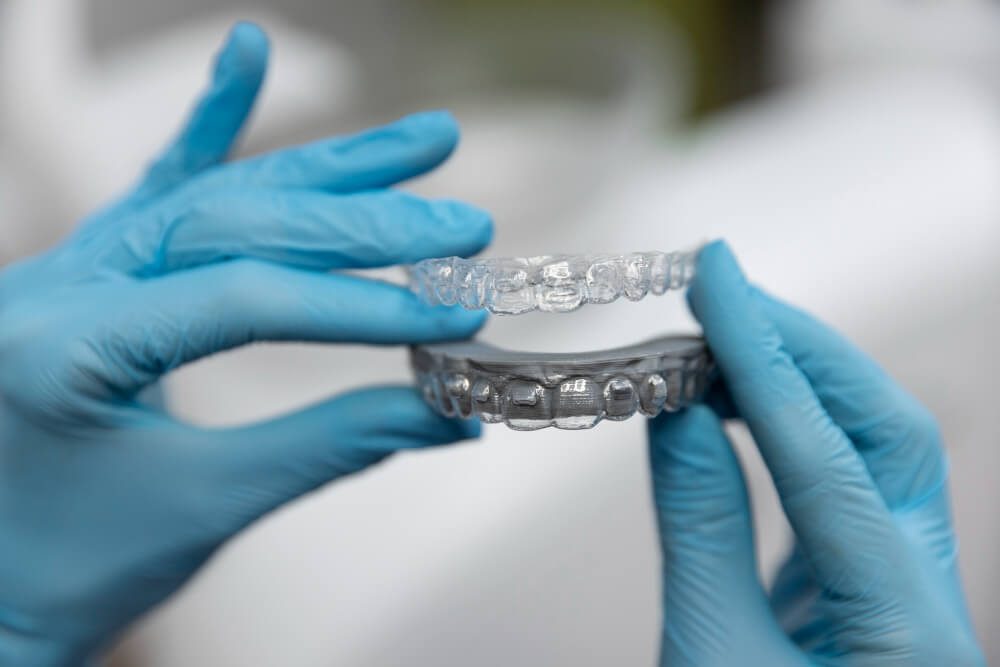Braces vs. Clear Aligners: Which Is Better for Straighter Teeth?

Braces vs. clear aligners—which is better for straighter teeth? Patients (or their parents) often ask us which orthodontic treatment delivers the best results.
Both can effectively straighten teeth, but the right choice depends on your specific needs.
While clear aligners like Invisalign, ClearCorrect, and SureSmile are great for mild to moderate cases, braces are often the better option for more complex orthodontic issues.
Before deciding, it’s essential to understand how each method works and which is better suited for your unique case.
Let’s compare braces and clear aligners to help you determine the best path to a straighter smile.
Clear aligners vs braces – how they differ
Braces are metal or ceramic brackets attached to the teeth with an archwire. Rubber bands help apply force, shifting the teeth into alignment.
Clear aligners are made from thermoplastic material and worn over the teeth like a mouthguard. Each customised aligner moves the teeth to their correct positions by harnessing natural forces.
Patients undergoing teeth straightening with braces will wear the fixed appliance throughout their orthodontic treatment, whereas Invisalign, ClearCorrect, and SureSmile use a series of clear aligners. The complexity of your case determines how many aligners are necessary.
Clear aligners vs braces – pros and cons
Appearance – Many patients prefer clear aligners because they provide a discreet teeth straightening method, unlike noticeable metal braces. However, tooth-coloured ceramic braces could be a good option if you have more complex dental problems but don’t want a mouthful of metal.
Diet – Patients with fixed braces need to be cautious since certain hard or sticky foods could bend or twist the wires. Diet isn’t a problem with clear aligners since they are removed to eat and drink anything other than water.
Oral hygiene – Brushing and flossing around fixed braces is challenging, and you may need to use specialised tools and floss to keep your teeth clean and free from food particles and bacteria. As mentioned above, it’s easy to stay on top of oral hygiene with aligners since they are removable.
Compliance – Patients who opt for clear aligners need to be committed to wearing them for at least 20-22 hours a day, only removing them to eat, drink, and clean their teeth. If they are out of the mouth for an extended period, it could disrupt treatment, and you may need more aligners to achieve the desired results. Naturally, this will extend the treatment duration and increase the price. With fixed braces, patients can get on with their everyday lives without such worries.
Comfort – Aligners are often more pleasant than braces since there are no wires to irritate or chafe the cheeks. However, each new aligner can feel tight and cause pain, although this subsides within days.
Treatment Time – The degree of misalignment affects how long a therapy takes. Braces usually take 18 months to 3 years to produce the desired effects. Clear aligners can deliver results for mild to moderate cases in as little as 6-18 months. However, treatment times are case-specific and should be discussed with your Northbridge dentist.
Appointments and Maintenance – Patients with braces need to visit their dentist regularly for adjustments, such as tightening wires or replacing rubber bands. These appointments can sometimes be lengthy. Clear aligner patients usually require fewer dental visits since they receive multiple aligners in advance. Check-ups are generally quick and involve monitoring progress and receiving new aligners.

Which Option Is Best for You?
The proper orthodontic treatment depends on multiple factors, including:
- The complexity of your case — Braces are better suited for severe misalignments, while aligners are great for mild to moderate corrections.
- Aesthetic preferences — Clear aligners offer a nearly invisible solution if discretion is prioritised.
- Commitment level—Braces may be great if you consistently wear aligners. If not, they ensure continuous treatment.
- Oral hygiene habits — Aligners make oral care easier, while braces require extra effort to maintain cleanliness.
- Lifestyle considerations — If you play contact sports or wind instruments, aligners may be a more convenient choice.
When used correctly, braces and clear aligners can deliver beautifully aligned smiles. Your Northbridge dentist can guide you toward the best choice based on your unique needs.
Orthodontics in Northbridge
At My Local Dentists, we are committed to helping you achieve the best smile possible. Whether you’re considering clear aligners or braces, our team is here to provide professional guidance and answer all your questions.
Call your Northbridge dentist today at (02) 8318 5966 or use our online booking service. We’ll soon put a smile on your face.
Visit us at Shop 20A Northbridge Plaza, 79-113 Sailors Bay Road in Northbridge.
